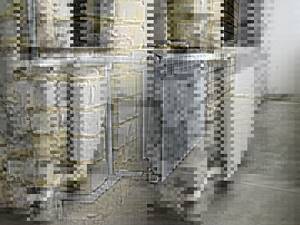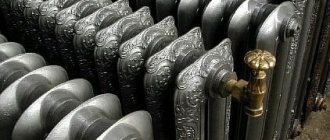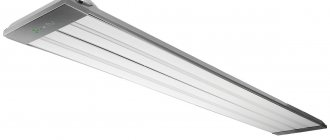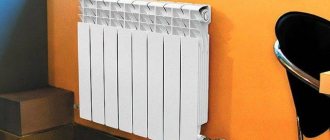Owners of apartment buildings, after glazing and insulating the loggia, think about the best way to heat the balcony in winter. If you choose the right heating device for your balcony, you will maintain a healthy microclimate and prevent dampness and fogging of the windows. More information about how to heat a balcony in winter will be discussed in this article.
Preparing for insulation
Before insulating the balcony, first study the condition of the parapet. To arrange a full-fledged room, it is first strengthened. Then modern double-glazed windows are installed. Additionally, they do waterproofing work and insulate the room.
To insulate the walls, they are laid out with bricks or foam blocks. Immediately after this, glazing can be done. To improve thermal insulation, you need to install high-quality double-glazed windows with a profile of at least three chambers. Important! It is best to entrust the work with glazing to professionals. They will assess the condition of the balcony, take measurements and do all the work.
All gaps between the parapet and the floor, as well as in the walls, are properly sealed, filled with construction foam or sealant. Protection from moisture is carried out using coating or roll waterproofing. After this, the walls and floor are sheathed with foam plastic, mineral wool or extruded polystyrene foam to reduce heat loss.
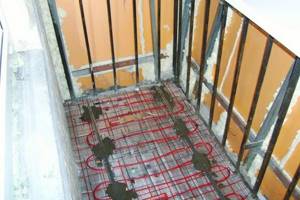
Do-it-yourself insulation of a balcony
If you don’t have time to do a full-fledged balcony repair with your own hands, use some folk methods of insulating a loggia. The temperature may rise by several degrees. Remember that this is a temporary measure. Such “tricks” cannot replace full thermal insulation.
Walk around the loggia with a candle or lighter. This will help determine from which joints and cracks the air is blowing. Seal them with putty. Draft is the worst enemy of heat.
Construct insulating panels from scrap pieces of foam. This material conducts heat poorly.
Such improvised insulation can be done in a few hours, but even this little thing reduces the chance of catching a cold from the cold coming from the loggia.
Insulating materials
The following types of insulation are available on the market:
- expanded clay;
- mineral wool;
- expanded polystyrene;
- polyurethane foam;
- penofol.
Choosing the optimal material is easier than it seems.
Expanded clay
This is the cheapest material. Does not hold its shape, readily absorbs moisture. Durable, resistant to fire, mold, mildew. It is used to insulate the floor on the balcony when they want to save money.
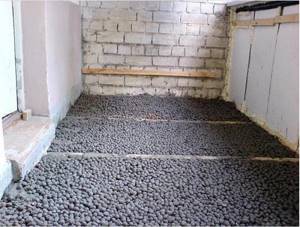
Insulating the floor on the loggia with expanded clay
Mineral wool
Medium price material. Its slabs are very wide, so they are not suitable for small spaces. The ingress of moisture impairs the insulating properties. Mineral wool is environmentally friendly, fire-resistant, and creates additional sound insulation.
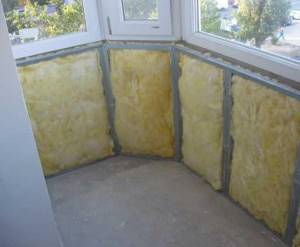
Balcony insulation with mineral wool
Expanded polystyrene
Expensive insulation, devoid of any shortcomings. The plates are easily attached to any surface using self-tapping screws. The best option for any room.
Polyurethane foam
Liquid insulation. Easily fills any cracks and cavities. Special equipment is required for installation. Dismantling presents some difficulties.
Penofol
Auxiliary thin heat and water insulator. It is used together with expanded polystyrene and mineral wool to create an additional air layer.
After you have chosen a thermal insulator, proceed with installation. First, all walls, floor, and ceiling must be covered with a layer of waterproofing made of polyethylene or foam foam, and the joints between the sheets must be glued with tape.
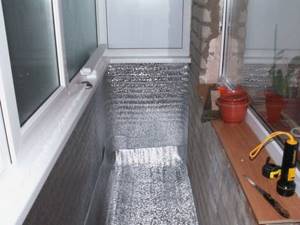
Balcony insulation with penofol
Then a metal or wooden frame is built (for more details, see the article “balcony sheathing”), into which the insulation will then be laid. The distance between it and the surfaces must be sealed with polyurethane foam. Next, the insulating boards are tightly laid. There should be no gap between them and the frame, otherwise all the work will go down the drain.
A rough covering of chipboard and plywood is built on top of this structure. You can install a heated floor on the loggia. Then finishing work is carried out.
Using heated floors
The most economical, safe and reliable way to heat a loggia is to install a heated floor. The heated air, rising, effectively and gently warms the entire room, capturing every corner.
There are two types of floor heating system design: electric and water. When installing a water floor, plastic pipes are used, laid inside a concrete screed. The heat carrier in them is hot water. The pipes are connected to the heating or hot water supply system through a manifold and pump. This additional equipment is placed in a special cabinet.
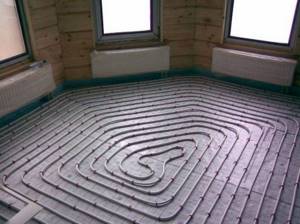
Photo 11. Water heated floor
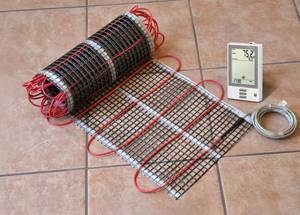
Photo 12. Electric heated floor
An electric heated floor can be mounted from a special cable laid along it in a zigzag pattern or by laying a special thermal film. In both cases, electrical energy is converted into thermal energy. To reduce heat loss, thermal insulation material is first laid. A heat cable is laid on top, fixed to the floor surface using special mounting strips and connected to a power source. Then it is filled with cement screed and left until completely dry. The main flooring is laid on top. Ceramics have the highest thermal conductivity, so tiled floors will warm up the loggia better and faster.
When laying the film covering, the finished strips are laid along the balcony and covered with a screed or simply covered with a carpet. The floor heating temperature is adjusted using a built-in thermostat, which maintains the specified operating mode. Using an electric heated floor to heat a loggia is the most economical and efficient compared to other methods.

Photo 13. Thermal film on the loggia
Heating a cold balcony is an important and pressing issue, the solution of which will create a healthy microclimate in the room. A correctly selected loggia heating system will significantly expand the living space, turning the balcony into a comfortable and warm corner of the apartment.
Features and characteristics of various heaters
Now let's move on directly to choosing a heating device. It is worth considering the features of all options, the pros and cons of the models, and also correlating the characteristics with the cost.
Ceramic heating panels
A ceramic heating panel is a modern heating device based on the action of infrared radiation.
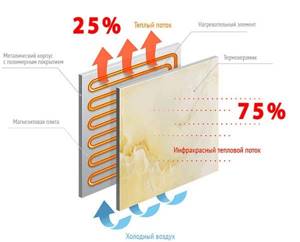
Such panels consist of a polymer body, with the help of which thermal energy is convected into the room, a heating element, a reflective screen and the ceramic panel itself. The housing and panel can withstand temperatures up to 90°C .
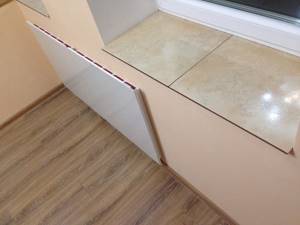
Ceramic heating panel Opal 375
The principle of operation of the heater is that infrared radiation heats the objects surrounding the device, and they, in turn, heat the air in the room.

The advantages of such ceramic heating devices:
- compactness, minimalistic appearance;
- Device efficiency up to 99%;
- do not dry the air and do not burn oxygen in the room;
- easy to install;
- energy savings are up to 30%, especially if the device has thermostats;
- complete environmental and fire safety.
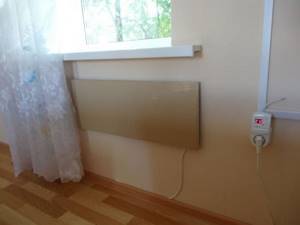
The only downside is the price of such a heater.
Naturally, it is worth purchasing only for the balcony that you often use.
Balcony heating with electrical appliances
To heat the balcony, you can also use electric convectors, oil radiators and fan heaters.
Advantages of electrical appliances:
- mobility, used for large and small balconies, as well as for any other premises;
- temperature sensors installed on electrical appliances make their operation safe;
- can be turned on only when necessary;
- do not “dry” the air.
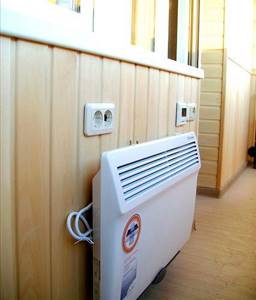
The use of such electrical appliances has one important drawback - a fairly large electricity consumption.
You will find more information about installing heated floors on balconies and loggias here.
The use of electrical appliances requires the presence of an outlet. Here you can read how to do it yourself.
If the room is warm even in winter, one of the ideas for arranging it could be creating a winter garden. Read more about this at the link https://balkonsami.ru/interer/ozelenenie/zimniy-sad-na-balkone-svoimi-rukami.html
Manufacturers and popular models: ranking of the best and prices
Among the popular models of balcony heaters, the following are worth highlighting.
IR heater Mister Heat Thermik S-0.1
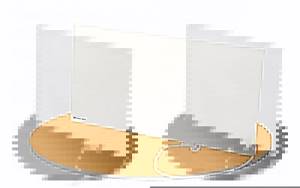
The infrared type device has a power of 100 W. The maximum surface heating is 60-100 degrees. If the device overheats, it turns off. The cost of the model is 1400 rubles.
Monolithic wall-mounted device Nikaten NT 330
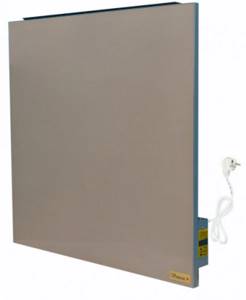
The wall-mounted device has a power of 330 W and heats a room up to 7 m2. The price of the device is 4200 rubles.
Heatphone Binar 1.0

The heater on wheels has a power of 1000 W and is able to work effectively in rooms up to 12 m2. Equipped with electronic control and temperature adjustment function. The cost of the equipment is 6,700 rubles.
Noirot Melodie Evolution (low) 750

The innovative device operates silently and is completely safe to use (rounded corners and maximum heating temperature of 60 degrees). Thanks to electronic automation, the device copes with voltage fluctuations of 150-242 V. The heater does not require grounding and can be used in damp rooms. Thanks to the mimetic coating of the body, the device is able to take on the dominant shade in the interior. The cost of the equipment is 18 thousand rubles.
Convector Ballu BEC/EZER-1500
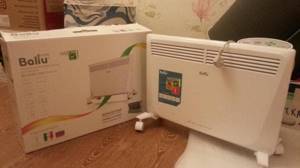
A convector heater, equipped with a power control function, successfully heats a room up to 20 m2. It is possible to regulate power modes - 750 or 1500 W. There is a built-in air ionizer. The cost of the device is 3000 rubles.
MEGADOR Light-150
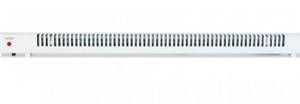
Energy-saving convector, capable of heating 10 m2. It is possible to switch the power to 200 or 400 W. The device is equipped with an air humidification system. The cost of the heater is 2800 rubles.
Infrared heater
It works on the principle of infrared floors - objects are heated first. And a person will also feel the warmth from the influence of its rays.
Infrared heater - the second sun on your balcony
Such a miracle has weaknesses. For example, a heater produces quite a lot of light, so at night it may interfere if your bedroom windows overlook the balcony. It is also very fragile, and the lamps heat up to 200 degrees. So it’s better not to stick your finger there.
But such a heater has the highest efficiency (efficiency factor) - 98%. This means that exactly the percentage of electricity that the heater consumed is converted into heat. At the same time, an infrared heater consumes less energy than the above-mentioned electric heaters.
In conclusion , we note that there are many more ways to heat a balcony. For example, put a carbon heater there, which consumes 25% less electricity! infrared. Yes, even an electric fireplace! The main thing is to insulate it well and correctly calculate the power of the heater. Otherwise, you will literally end up wasting your money.
Types of devices
According to the fuel used, heaters are divided into:
- electrical;
- gas;
- diesel
The last two types are not used for home use. Their function is to heat large areas and utility rooms. Therefore, exclusively electric models can be used to heat balconies and loggias. Depending on the type of heater, the following types are distinguished:
- Ceramic, in which the heater is a dielectric placed in a ceramic panel that transmits infrared radiation. This type of device is usually mounted.
- Carbon heaters are more modern models. The heating element is a quartz tube filled with carbon fiber. The devices are distinguished by high efficiency and also cost.
- In film devices, the heating element is usually a flexible cable with a high level of resistance, which heats the metal film. Such devices are installed on prepared foundations. They are highly flexible, so you can give them the desired shape.
Water floor heating
The water heating system is a polymer tube that is installed under the screed. It can be connected to both a gas boiler and a central heating system.
Don't forget to check the water heating on the balcony before screeding it. This can save you from paying compensation to your flooded neighbors.
Advantages – low price.
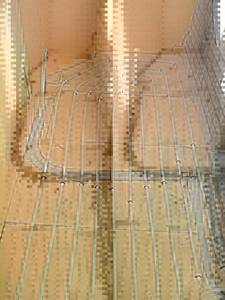
Flaws:
- damage to the tube can lead to a flood;
- fragility;
- Difficult to connect to central heating system.
Conclusion: a budget balcony heating system, which makes sense to install if you have an economical gas boiler.
How to heat a balcony in winter: popular options
Before installing heating on the balcony, it is necessary to finish it and insulate it. How to make it suitable for living all year round? You can use one of seven options.
Traditional steam heating
Installing an additional battery for a balcony or loggia is a great idea, because this method is simpler than others and has no equal in terms of efficiency. But there is a big disadvantage - this is the possibility of encountering legal problems. The fact is that removing the battery will probably be illegal. It is futile to hope that no one will notice anything.
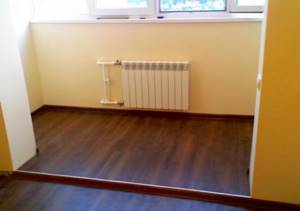
When one of the residents of an apartment building has an individual battery on the balcony, residents of neighboring apartments may feel a decrease in heat transfer from their own radiators. The reason lies in the design features of central heating. However, this method should not be written off prematurely. Such issues are discussed with housing and communal services employees - with their help you can obtain the necessary permission.
Electric heating
The balcony heater can also operate using electricity. This is equipment such as a convector or oil heater. Easy to install, it is ideal because it can be turned on and off as needed. But there are also significant disadvantages. The first and main one is an increase in energy costs.
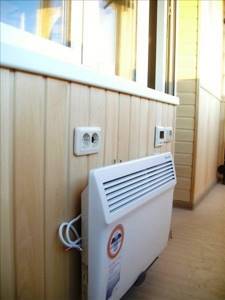
The second drawback is the unpleasant odor that appears due to low air humidity in such a small room as a loggia or balcony. It is enough to install an air humidifier in a heated balcony to prevent this from happening. The third disadvantage is the increased fire hazard. Installing an oil heater is justified where they do not spend too much time on the loggia.
Infrared heating
A rather innovative way to make a balcony or loggia warm is with ceiling and wall infrared panels.
The effect of infrared heat on the surrounding space is similar in its properties to sunlight. Modern infrared heaters for the balcony will not only make it suitable for permanent use in winter, but will also have a very positive effect on the walls and floor.

Infrared light will prevent condensation from accumulating on the walls and prevent the possibility of mold or mildew.
This is one of the cleanest methods of heating a loggia from an environmental point of view. In addition, it is very economical.
But the installation itself cannot be called cheap. In addition, if the loggia is large, then the infrared heater may not be able to adequately heat the room.
Warm floor
If you want to include floor heating in your loggia heating, then this option is best suited. There is just one important point: the heated floor is laid before pouring the concrete screed. Read more about this method here.
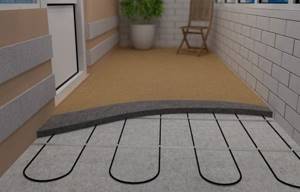
If the balcony is small, then one heated floor is enough to heat the entire room. The method is good for its effectiveness, but difficult to install. There is also some fire hazard (for the electric type).
Warm baseboard
This is a modern balcony heating that came to us recently from European countries. It is installed instead of a regular baseboard, but has a heat exchange heating module inside. Usually these are two copper tubes with brass lamellas. This type of balcony heating includes a distribution manifold, from which the coolant is supplied to the heater. Like the floor, a warm baseboard can be powered by electricity or water.

Solar panels
Solar panels for apartment heating have appeared quite recently. Heating on the loggia using solar energy is convenient for owners of private houses. It is problematic to implement this in a city high-rise building, but it is possible. But still, a solar battery on an ordinary balcony is a rare occurrence. In the Russian climate, the option of such heating is, of course, controversial.
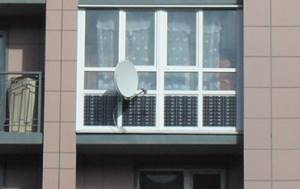
In addition, this is one of the most expensive ways to heat a balcony - it all depends on the cost of solar panels. The solar battery itself on your balcony will not create a warm atmosphere: it only collects solar heat, which is converted into electricity through a special device. The electricity can then be used to power a heater.
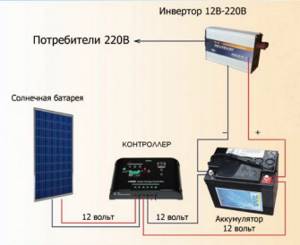
The principle of operation of a solar battery
Which balcony heater is more economical?
The efficiency and economy of heating depends on a properly selected heater. First of all, this concerns power. In the case of electric models, you need to take into account an important rule: regardless of the design of the device and the principle of its operation, 100 W of power is required for high-quality heating of 1 m2 of area.
Infrared models optimally heat the entire balcony space if they are suspended from the ceiling
In addition to power, other important parameters are taken into account:
- Installation method. Conventional portable heaters can be installed anywhere. Even wall-mounted models can be easily moved by screwing the brackets into a new location. It is difficult to dismantle an electric heated floor if it is not suitable for heating. Here you need to consider whether it is worth laying electric mats on the balcony.
- Duration of work. For short-term heating, a cheap manually operated electric heater is suitable. If you need a device for constant heating, it must have the ability to operate autonomously.
- Safety. Electrical appliances are dangerous in terms of electric shock and fire. If they will be operated unattended or accessible to children, be sure to have auto shut-off functions in case of overturning, overheating, or short circuit.
In terms of efficiency, infrared heaters win. They consume little electricity, have high efficiency, but are expensive. You will have to pay for the efficiency, but the costs will pay off with daily use. Warm floors will be expensive and will require hiring experienced specialists. This option is optional. Conventional electrical appliances with coils and heating elements are cheap, but consume a lot of electricity. They are beneficial for occasional use.
Is it possible to take the battery out onto the loggia?
In each individual region, the ban on bringing central heating into the territory of the loggia is regulated by its own documentation. But the general basis for prohibiting such redevelopment remains the same. If you remove the radiator of your own free will, you may be fined.
Also, you will have to comply with the requirement to remove the battery and return it to its original place.
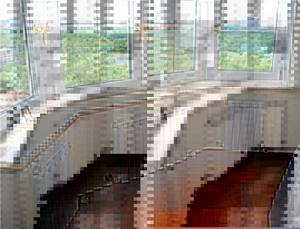
However, some apartment owners are trying to legalize the removal of heating to the loggia. To do this, you need to contact the management company that maintains the house. It is necessary to agree on a plan for future redevelopment with her and obtain the necessary permission.
There are no guarantees that you will still be able to get it.

But it is worth remembering that inserting another battery will reduce the overall pressure on the heating system, and this can lead to cooling not only of your apartment, but also of all other rooms in the house.
